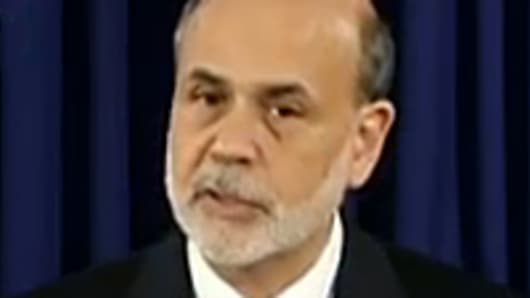The Federal Reserve, seeing a further slowdown in the US economy, hinted strongly Wednesday that it is prepared to launch a third round of quantitative easing, or QE3.
The Fed, following a two-day meeting, said it would continue "Operation Twist" through the end of the year at the current pace. Under the program, the central bank will buy long-dated Treasurys—six- to 30-year durations—and sell the same amount of shorter-term securities, dated three-years or less, in a bid to keep rates low.
There were some expectations the Fed would embark on a new quantitative easing program, or QE3, so the market was initially disappointed. In that program, the Fed asset purchases expand its balance sheet, unlike Twist.
The Fed also lowered its growth projections for 2012 through 2014 and lowered its expectations for new hiring. And both the Fed statement and Chairman Ben Bernanke held out the prospect of more easing, if the economy needs it.
"Yes, additional asset purchases are among the things we would consider if we need to take additional measures to strengthen the economy," Bernanke said during his quarterly press briefing.
However, Bernanke warned there is a cost associated with easing programs and they can't be taken lightly.
"We're prepared to do more. We have to get additional information on the state of the economy, what's happening in Europe."
The Fed statement opened the door wider to the possibility of more QE, in stronger terms than normal.
Traders latched onto a line, saying the Fed is "prepared to take further action." That replaces its last comment that it would "regularly review the size and composition of its securities" and will adjust the holdings as appropriate to promote a stronger recovery.
“Those were strong words," said John Canally, investment strategist and economist at LPL Financial. "It’s like saying one more weak report, one more hiccup in Europe, one more something, and they’re ready to go."
Stocks immediately fell on the Fed statement at midday, then erased losses but then fell again while Bernanke spoke in the 2 p.m. hour.
"He gave a rather somber outlook and then when asked.. 'why aren't you doing something about it?' He didn‘t have a solid answer," said Art Cashin, director of floor operations at UBS.
Cashin said stocks were helped by headlines from German Chancellor Merkel that the EFSF, the euro zone rescue fund, could possibly make sovereign bond purchases.
Treasury yields initially moved as would be expected, with longer duration Treasury yields falling and shorter duration yields rising. The dollar strengthened, and the euro gave up gains.
In Twist, the Fed is extending its programs now from the end of June through the end of the year. The Fed’s statement also carried a new more somber tone about the state of the economy, noting growth in employment has slowed, as opposed to its view in April that the labor market conditions have improved.
The Fed's new forecast puts unemployment this year at between 8 and 8.2 percent, up from 7.8 to 8 percent, and next year it sees unemployment of 7.5 to 8 percent, up from its prior projection of 7.3 to 7.8 percent.
It warned that household spending appears to be rising at a slower pace, though it noted that inflation declined. The Fed also said growth would pick up “very” gradually, as opposed to just gradually in its April statement.
The Fed now expects growth of 1.9 to 2.4 percent in 2012, down from its previous 2.4 to 2.9 percent forecast. It also trimmed growth for 2013 to 2.2 to 2.8 percent, from 2.7 to 3.1 percent, and 2014 growth was forecast at 3 to 3.5 percent.
The reaction to the Fed news was mixed. While many economists expected action from the Fed, some saw little positive impact from it.
"Extra Twist will do very little to boost growth, but the Fed clearly wants to be seen to be doing something," said Ian Shepherdson, Chief U.S. Economist at High Frequency Economics, in a note.
But Paul Edelstein, director of financial economics at IHS Global, called the decision “no brainer.”
"Downside risks—primarily the Eurozone debt crisis and Chinese slowdown—are percolating, threatening the US recovery. Meanwhile, two consecutive months of sub-100,000 jobs growth calls into question the underlying momentum of the economy," Edelstein wrote.
"And while the jobs market probably isn’t as weak as the April/May numbers indicate, it pays for the Fed to insure against downside possibilities. Meanwhile, duration twist involves no additional inflation risk as bank reserves aren’t being created, making the program more palatable to some Fed members," he noted.
Wall Street had a wide range of expectations going into the Fed meeting. Some of those expectations forecasts included that the Fed might purchase mortgage securities.
The reason for the varied expectations, some Fed watchers say, may be that the Fed's communications, through various Fed member speeches, may not have been able to keep up with the rapid changes in the economy and in Europe.
BlackRock's Peter Fisher, head of fixed income, said earlier he expected the Fed to extend Twist, but that's not what he wanted it to do.
"I don't think either Twist or balance sheet expansion here has much more room to be effective. If they keep taking long duration assets, long-term Treasurys out of the market, they're denying the banking system the best collateral in the banking system," Fisher said on CNBC's "Squawk Box."
"That doesn't' help stimulate private credit so the trade off between lowering long term rates and sucking Treasurys out of the market looks to be not producing returns for them anymore...I don't think it's working," he said.
Follow Patti Domm on Twitter: @pattidomm
Questions? Comments? Email us at marketinsider@cnbc.com



